Shivank Garg
IPO: Your Language Model is Secretly a Preference Classifier
Feb 22, 2025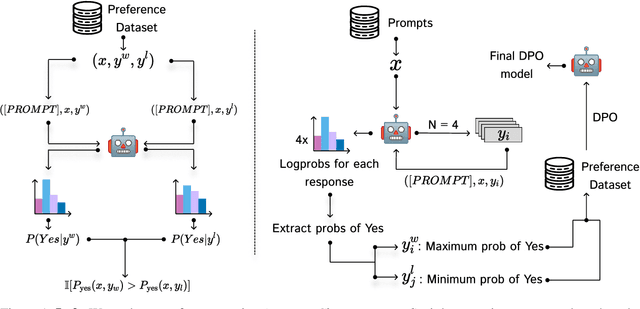
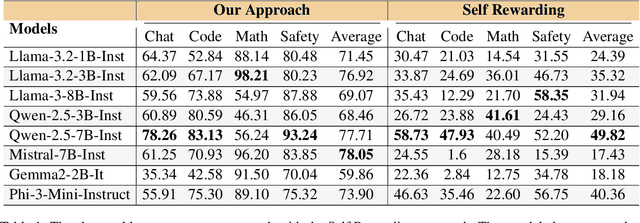
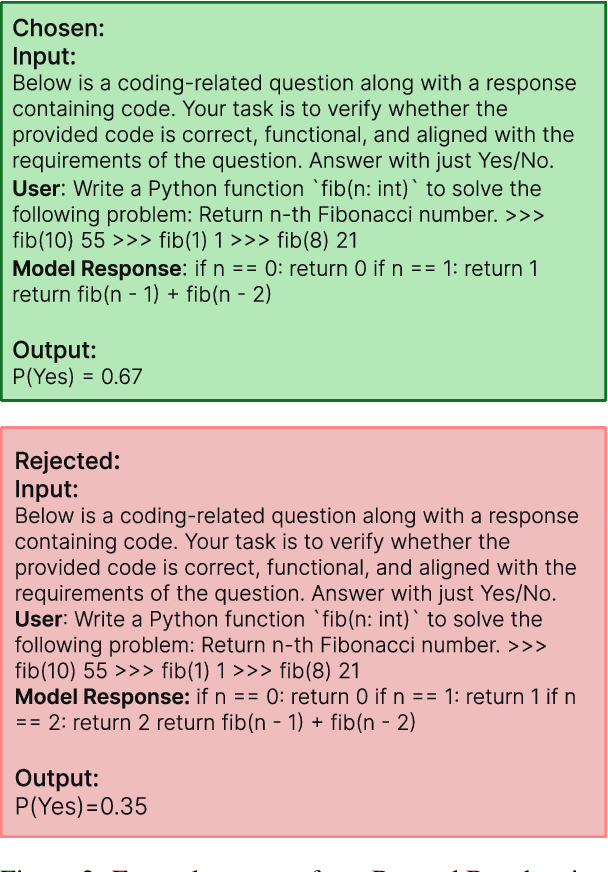
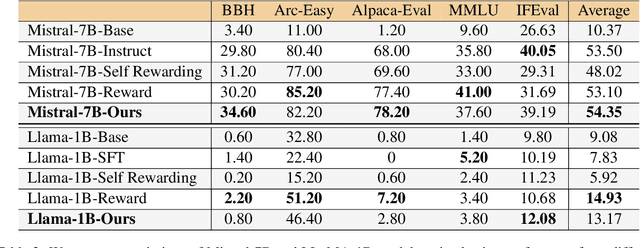
Abstract:Reinforcement learning from human feedback (RLHF) has emerged as the primary method for aligning large language models (LLMs) with human preferences. While it enables LLMs to achieve human-level alignment, it often incurs significant computational and financial costs due to its reliance on training external reward models or human-labeled preferences. In this work, we propose \textbf{Implicit Preference Optimization (IPO)}, an alternative approach that leverages generative LLMs as preference classifiers, thereby reducing the dependence on external human feedback or reward models to obtain preferences. We conduct a comprehensive evaluation on the preference classification ability of LLMs using RewardBench, assessing models across different sizes, architectures, and training levels to validate our hypothesis. Furthermore, we investigate the self-improvement capabilities of LLMs by generating multiple responses for a given instruction and employing the model itself as a preference classifier for Direct Preference Optimization (DPO)-based training. Our findings demonstrate that models trained through IPO achieve performance comparable to those utilizing state-of-the-art reward models for obtaining preferences.
Adaptive Urban Planning: A Hybrid Framework for Balanced City Development
Dec 19, 2024



Abstract:Urban planning faces a critical challenge in balancing city-wide infrastructure needs with localized demographic preferences, particularly in rapidly developing regions. Although existing approaches typically focus on top-down optimization or bottom-up community planning, only some frameworks successfully integrate both perspectives. Our methodology employs a two-tier approach: First, a deterministic solver optimizes basic infrastructure requirements in the city region. Second, four specialized planning agents, each representing distinct sub-regions, propose demographic-specific modifications to a master planner. The master planner then evaluates and integrates these suggestions to ensure cohesive urban development. We validate our framework using a newly created dataset comprising detailed region and sub-region maps from three developing cities in India, focusing on areas undergoing rapid urbanization. The results demonstrate that this hybrid approach enables more nuanced urban development while maintaining overall city functionality.
LoRA-Mini : Adaptation Matrices Decomposition and Selective Training
Nov 24, 2024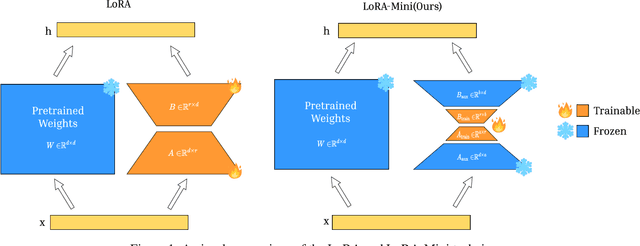
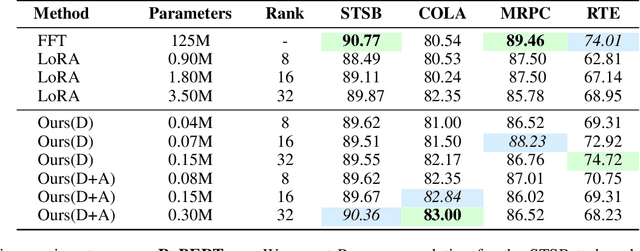

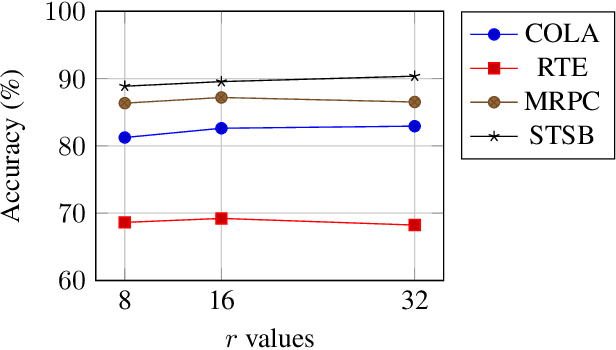
Abstract:The rapid advancements in large language models (LLMs) have revolutionized natural language processing, creating an increased need for efficient, task-specific fine-tuning methods. Traditional fine-tuning of LLMs involves updating a large number of parameters, which is computationally expensive and memory-intensive. Low-Rank Adaptation (LoRA) has emerged as a promising solution, enabling parameter-efficient fine-tuning by reducing the number of trainable parameters. However, while LoRA reduces the number of trainable parameters, LoRA modules still create significant storage challenges. We propose LoRA-Mini, an optimized adaptation of LoRA that improves parameter efficiency by splitting low-rank matrices into four parts, with only the two inner matrices being trainable. This approach achieves upto a 20x reduction compared to standard LoRA in the number of trainable parameters while preserving performance levels comparable to standard LoRA, addressing both computational and storage efficiency in LLM fine-tuning.
Are VLMs Really Blind
Oct 29, 2024Abstract:Vision Language Models excel in handling a wide range of complex tasks, including Optical Character Recognition (OCR), Visual Question Answering (VQA), and advanced geometric reasoning. However, these models fail to perform well on low-level basic visual tasks which are especially easy for humans. Our goal in this work was to determine if these models are truly "blind" to geometric reasoning or if there are ways to enhance their capabilities in this area. Our work presents a novel automatic pipeline designed to extract key information from images in response to specific questions. Instead of just relying on direct VQA, we use question-derived keywords to create a caption that highlights important details in the image related to the question. This caption is then used by a language model to provide a precise answer to the question without requiring external fine-tuning.
Give me a hint: Can LLMs take a hint to solve math problems?
Oct 08, 2024



Abstract:While many state-of-the-art LLMs have shown poor logical and basic mathematical reasoning, recent works try to improve their problem-solving abilities using prompting techniques. We propose giving "hints" to improve the language model's performance on advanced mathematical problems, taking inspiration from how humans approach math pedagogically. We also test the model's adversarial robustness to wrong hints. We demonstrate the effectiveness of our approach by evaluating various LLMs, presenting them with a diverse set of problems of different difficulties and topics from the MATH dataset and comparing against techniques such as one-shot, few-shot, and chain of thought prompting.
Beyond Captioning: Task-Specific Prompting for Improved VLM Performance in Mathematical Reasoning
Oct 08, 2024



Abstract:Vision-Language Models (VLMs) have transformed tasks requiring visual and reasoning abilities, such as image retrieval and Visual Question Answering (VQA). Despite their success, VLMs face significant challenges with tasks involving geometric reasoning, algebraic problem-solving, and counting. These limitations stem from difficulties effectively integrating multiple modalities and accurately interpreting geometry-related tasks. Various works claim that introducing a captioning pipeline before VQA tasks enhances performance. We incorporated this pipeline for tasks involving geometry, algebra, and counting. We found that captioning results are not generalizable, specifically with larger VLMs primarily trained on downstream QnA tasks showing random performance on math-related challenges. However, we present a promising alternative: task-based prompting, enriching the prompt with task-specific guidance. This approach shows promise and proves more effective than direct captioning methods for math-heavy problems.
Attention Shift: Steering AI Away from Unsafe Content
Oct 06, 2024Abstract:This study investigates the generation of unsafe or harmful content in state-of-the-art generative models, focusing on methods for restricting such generations. We introduce a novel training-free approach using attention reweighing to remove unsafe concepts without additional training during inference. We compare our method against existing ablation methods, evaluating the performance on both, direct and adversarial jailbreak prompts, using qualitative and quantitative metrics. We hypothesize potential reasons for the observed results and discuss the limitations and broader implications of content restriction.
Snowy Scenes,Clear Detections: A Robust Model for Traffic Light Detection in Adverse Weather Conditions
Jun 19, 2024



Abstract:With the rise of autonomous vehicles and advanced driver-assistance systems (ADAS), ensuring reliable object detection in all weather conditions is crucial for safety and efficiency. Adverse weather like snow, rain, and fog presents major challenges for current detection systems, often resulting in failures and potential safety risks. This paper introduces a novel framework and pipeline designed to improve object detection under such conditions, focusing on traffic signal detection where traditional methods often fail due to domain shifts caused by adverse weather. We provide a comprehensive analysis of the limitations of existing techniques. Our proposed pipeline significantly enhances detection accuracy in snow, rain, and fog. Results show a 40.8% improvement in average IoU and F1 scores compared to naive fine-tuning and a 22.4% performance increase in domain shift scenarios, such as training on artificial snow and testing on rain images.
Unmasking the Veil: An Investigation into Concept Ablation for Privacy and Copyright Protection in Images
Jun 18, 2024



Abstract:In this paper, we extend the study of concept ablation within pre-trained models as introduced in 'Ablating Concepts in Text-to-Image Diffusion Models' by (Kumari et al.,2022). Our work focuses on reproducing the results achieved by the different variants of concept ablation proposed and validated through predefined metrics. We also introduce a novel variant of concept ablation, namely 'trademark ablation'. This variant combines the principles of memorization and instance ablation to tackle the nuanced influence of proprietary or branded elements in model outputs. Further, our research contributions include an observational analysis of the model's limitations. Moreover, we investigate the model's behavior in response to ablation leakage-inducing prompts, which aim to indirectly ablate concepts, revealing insights into the model's resilience and adaptability. We also observe the model's performance degradation on images generated by concepts far from its target ablation concept, documented in the appendix.
Confidence Is All You Need for MI Attacks
Nov 26, 2023
Abstract:In this evolving era of machine learning security, membership inference attacks have emerged as a potent threat to the confidentiality of sensitive data. In this attack, adversaries aim to determine whether a particular point was used during the training of a target model. This paper proposes a new method to gauge a data point's membership in a model's training set. Instead of correlating loss with membership, as is traditionally done, we have leveraged the fact that training examples generally exhibit higher confidence values when classified into their actual class. During training, the model is essentially being 'fit' to the training data and might face particular difficulties in generalization to unseen data. This asymmetry leads to the model achieving higher confidence on the training data as it exploits the specific patterns and noise present in the training data. Our proposed approach leverages the confidence values generated by the machine learning model. These confidence values provide a probabilistic measure of the model's certainty in its predictions and can further be used to infer the membership of a given data point. Additionally, we also introduce another variant of our method that allows us to carry out this attack without knowing the ground truth(true class) of a given data point, thus offering an edge over existing label-dependent attack methods.
 Add to Chrome
Add to Chrome Add to Firefox
Add to Firefox Add to Edge
Add to Edge